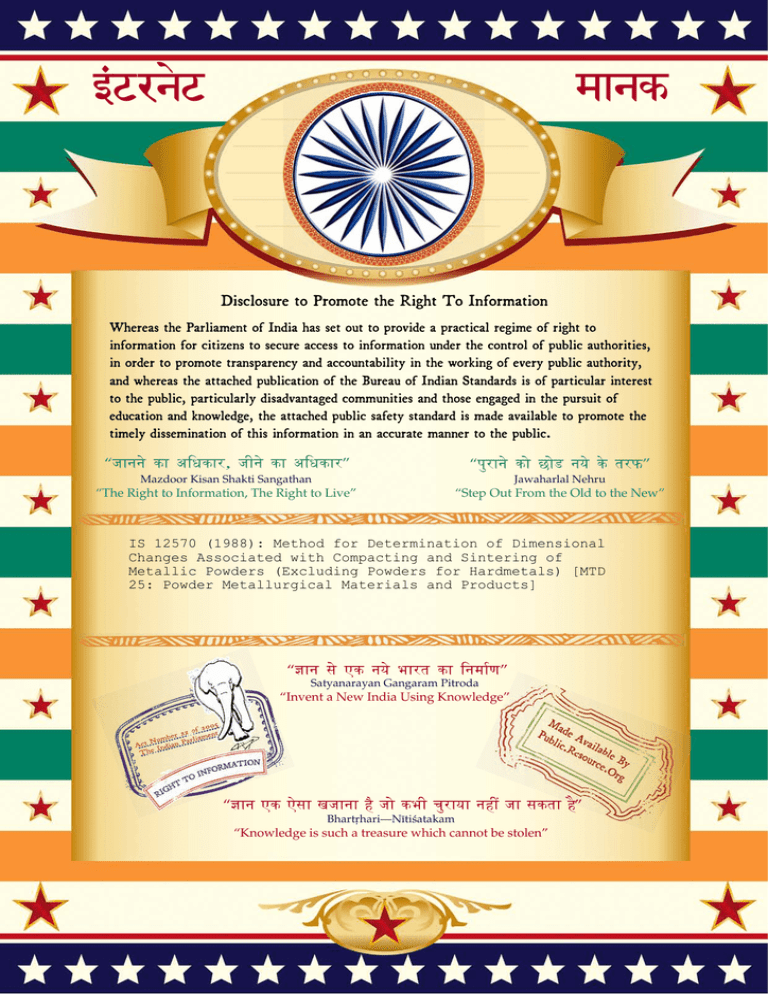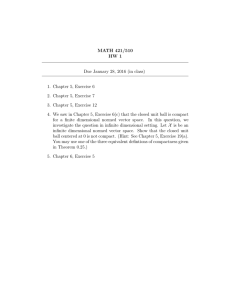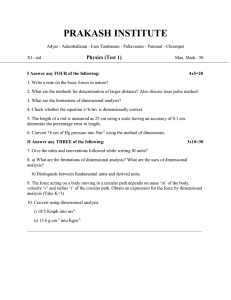IS 12570 (1988): Method for Determination of Dimensional Changes
advertisement

इंटरनेट मानक Disclosure to Promote the Right To Information Whereas the Parliament of India has set out to provide a practical regime of right to information for citizens to secure access to information under the control of public authorities, in order to promote transparency and accountability in the working of every public authority, and whereas the attached publication of the Bureau of Indian Standards is of particular interest to the public, particularly disadvantaged communities and those engaged in the pursuit of education and knowledge, the attached public safety standard is made available to promote the timely dissemination of this information in an accurate manner to the public. “जान1 का अ+धकार, जी1 का अ+धकार” “प0रा1 को छोड न' 5 तरफ” “The Right to Information, The Right to Live” “Step Out From the Old to the New” Mazdoor Kisan Shakti Sangathan Jawaharlal Nehru IS 12570 (1988): Method for Determination of Dimensional Changes Associated with Compacting and Sintering of Metallic Powders (Excluding Powders for Hardmetals) [MTD 25: Powder Metallurgical Materials and Products] “!ान $ एक न' भारत का +नम-ण” Satyanarayan Gangaram Pitroda “Invent a New India Using Knowledge” “!ान एक ऐसा खजाना > जो कभी च0राया नहB जा सकता ह” है” ह Bhartṛhari—Nītiśatakam “Knowledge is such a treasure which cannot be stolen” UDC IS : 12570 - 1988 669-492’2-138‘8 ( Reaffirmed 1999 ) Indian Standard METHOD FOR DETERMINATION OF DIMENSIONAL CH&NGES ASSOCIATED WITH COMPACTING SINTERING OF METALLIC POWDERS (EXCLUD-ING POWDERS FOR HARDMETALS) “;_ AND 1. scope 1.1 This standard specifies a method by which the dimensional changes associated and sintering of metallic pow ers are compared with those of a reference powder under similar conditions ( see?3 ). 1.2 The method applies to the determination of three types of dimensional processing of metallic powders, excluding powders for hardmetals. changes with when involved compacting processed with the 2. Principle 5 a 2.1 The test consists of compacting of a metallic powder or powder mix with admixed lubricant to Measurement produce a test piece of given density and then sintering it under controlled conditions. Calculation of dimensions of the unloaded die cavity, the green compact and the sintered test piece. of the algebraic difference between these various measurements as a percentage of the dimension of the die cavity or the green compact ( see 8 ). 2.2 Standard test pieces made from a reference powder are processed together test and the dimensional changes of the two powders are reported. 3. Test with the sample under Parameters 3.1 The reference powder shall be chosen by agreement between the supplier and the user and shall have a composition and properties as close as possible to those of the powder to be tested. 3.2 The following three types of dimensional change are dealt with in this standard. 3.2.1 From die size to green size (spring back) - The increase in dimensions measured at right angles to the direction of pressing, after being ejected from the die. 3.2.2 From green size to sintered size ( sintered dimensional change ) of an object that occurs as a result~of sintering. 3.2.3 of a compact, The change in dimensions From die size to sintered size ( total dimensional change ) 4. Symbol, Designation and Units - See Table 1. “’ TABLE f SYMBOL, DESIGNATION AND UNIT Designation Symbol Adopted Unit do Test dimension of unloaded die mm dG Test dimension of green compact mm ds Test dimension of sintered Adcx Spring A&s Sintered A dDS Total dimensional 15 -November back dimensional 0 1988 June change change 1989, BUREAU parcent ( + ) percent ( -f- or -) percent ( + or-) Or 2 BIS I I MANAK mm compact OF BHAVAN, INDIAN . STANDARDS 9 BAHADUR SHAH NEW DELHI 110002 ZAFAR MARG IS : 12570 - 1988 5. Apparatus 5.1 Tool Set - that will produce cylindrical test piece ( see Fig. 1 ), rectangular or test pieces similar to the actual components. 5.2 Press - capable of applying 5.3 Balance - test piece the pressures necessary to achieve the required density. capable of weighing at least 100 g to an accuracy of &to’01 g. 5.4 Micrometer or Other Suitable Measuring Device -for and the die to an accuracy of f0.005 mm. measuring the dimensions of the UPPER L:H-10 LOWER PUNCH L:H *35 PUNCHES All dimensions FIG. 1 EXAMPLE ( see Fig. 2 ) OF TOOLING in millimetres. TO PRODUCE A CYLINDRICAL TEST PIECE compacts IS;12570 CEMENTED -1988 CARBIDE UPPER PUNCH DIE Note PUNCHES - Mating parts shall be fitted and lapped. All dimensions FIG. 2 EXAMPLE OF TOOLING in millimetres. TO PRODUCE A RECTANGULAR sintering 5.5 Sintering Furnace - capable of producing atmosphere ) as close as possible to those used in industry 6. Sampling - Representative quantities of both the give at least three compacts shall be taken, TEST PIECE and conditions (time-temperature curve for the type of material to be tested. test and the reference powders sufficient to 7. Procedure 7.1 The test powder and the reference powder shall be mixed under the same conditions with the same mass of additives, including lubricant, to produce the composition of the sintered components for which the powder is required. 7.1 .l A test powder supplied ready for pressing shall be tested in the as-received 7.1.2 To avoid the possibility of distortion should be not less than 5 mm thick. during sintering, 7.2 Measure, to the nearest 0’005 mm, the test dimension unloaded condition and record the value, do, obtained. 7.3 Press at the agreed density prepared as in 7.1. at least three compacts 7.4 Measure, to the nearest 0’005 mm, the test dimension dG, obtained. it is recommended (diameter from both condition. that the test pieces die in the or length ) of the the test of the green compact and and reference record powders the value 7.5 Sinter the test and reference compacts adjacent to each other under the conditions of time, temperature and atmosphere which stimulate production conditions to be used for the sintered components for which the test powder is required. Note - The support for the test pieces to prevent distortion ( that is, ceramic plate or furnace belt ), the rate of heat-up, the atmosphere and the cooling rate may affect the dimensional change being measured, and should be consistent. 7.6 After cooling to room temperature, measure to the nearest 0’005 mm, the test dimension of the sintered test and reference compacts and record the value, ds, obtained, ensuring that the dimensions before and after sintering are taken from the same position on the compacts. 3 IS:12570 -1988 8. Test Results 8.1 The dimensional 8.1.1 changes, expressed as percentages, & = - do x do 100 Sintered dimensional change ( positive or negative ) ndGs 8.1.3 formulae: Green dimensional change (spring back ) ( positive ) n&e 8.1.2 are given by the following ds--GdGx = 100 Total dimensional change ( positive or negative ) Ados ds - do do = x 100 8.2 Report the dimensional changes for both the test and reference powders three determinations rounded to the nearest 0’01 percent. 9. Test Report - The test report shall include the following as the average of at least information: Reference to this standard; 4 b) c) All details necessary for indentification 4 The type of test piece, and its dimensions All details necessary for identification of the test sample; of the reference powder; before sintering; e) The density of the green compact; f) 9) h) Sintering The result details; obtained; and Details of any occurrence which may have affected the result. EXPLANATORY NOTE In the preparation of this standard, assistance has been derived from IS0 : 4492-1985 ‘Metallic of dimensional changes associated with powders, excluding powders for hardmetals -,Determination compacting and sintering’ issued by the International Organization for Standardization ( IS0 ). 4 Printed at Printrade, New Delhi, India


